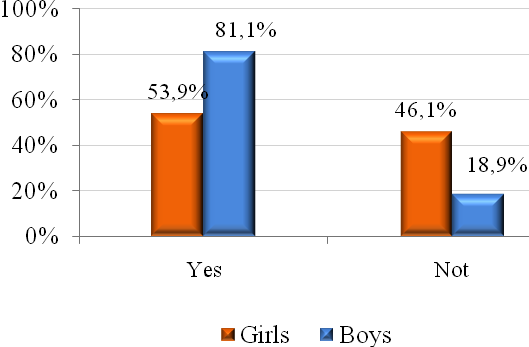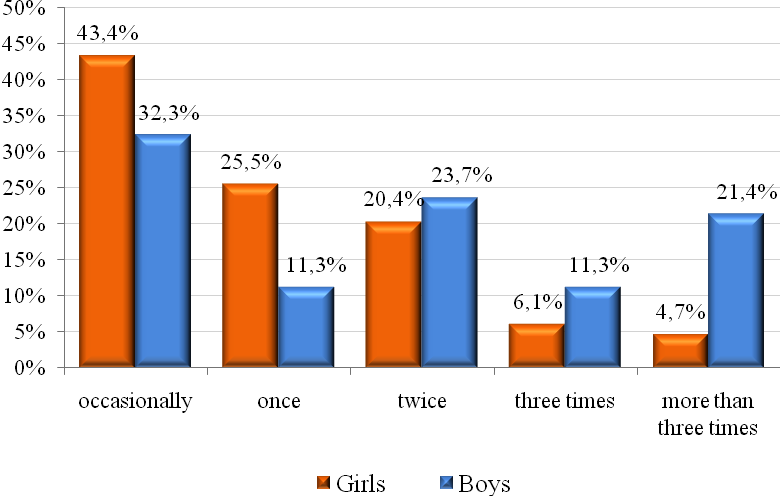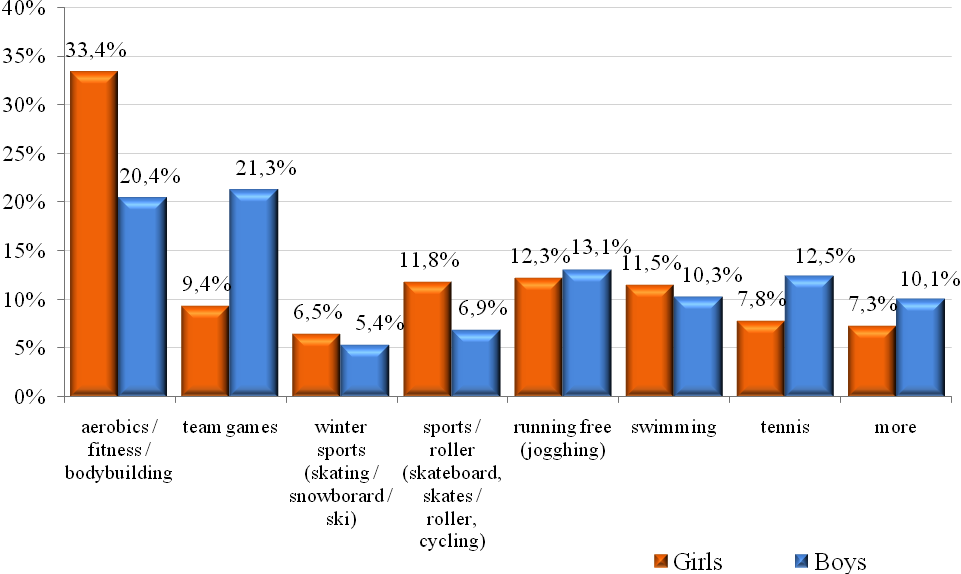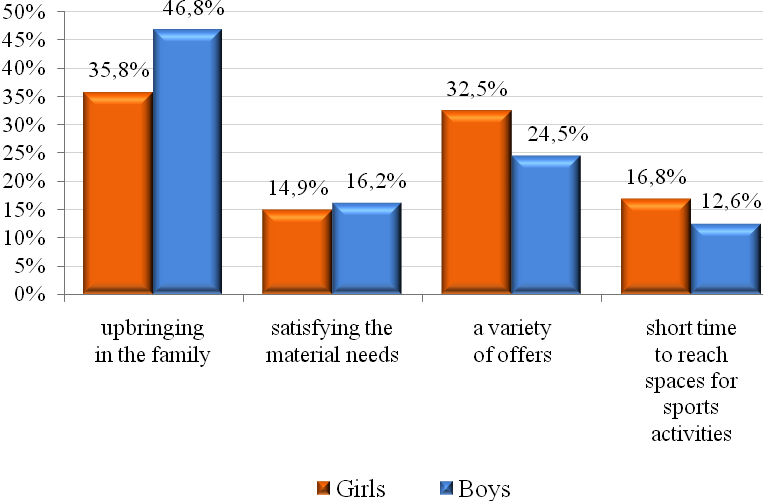Abstract
Concerning the location of the residence, the opportunities of some special organized places for physical and sport activities, the objective and subjective matters specifically for the social and educational environment, this study aims to determine the free time budget of the students of the University of Bucharest with the main favorite spare-time activities. The method of the questionnaire, the statisticallymathematical method, the method of graphical representation. The two parts of the students that are included in the presentation are the following: 858 girl and 271 boys, from all the study-years, including the master. They are part of the 18 faculties of the University of Bucharest and of the sport and physical education courses. The social issues influence to some extent the motivation for sport activities in the spare-time (the lack of special-organized spaces) and moreover, other issues are the comfort, education and an unorganized lifestyle. From the processing of the data turns out that the questioned students practice the sport activities in their spare-time, mostly in group. However, the subjects from both categories dispose of spare time of between 1 and 4 hour with a percentage of 84,1 % foe girls and 78,2% for boys. The girls prefer the sport activities that are mainly sedentary whereas the boys prefer sport activities.
Keywords: Time budgetstudentseducationsocial issueslifestyle
Introduction
„The society of nowadays is characterized by alert working rhythms that induce pressures,
sometimes hard to counteract by the subjects, unable to resonate or to synchronize with these. The rigor
which time is shared with leads to the notion of
limited resource which has to be wisely managed” (Bota, 2006: 11-13).
Regarding the spare time there always appear new terms and interpretations. This way, Miller and
Robinson (Ganciu in 2010: 39), two tourism analysts in whose presentations we encounter for the first
time the difference between spare-time, which means the time one disposes of after the necessary work or
other activities and liabilities that are met.
“In modern conception, health is considered as a state that contains elements of physical, social
and psychological nature. Not only is it enough for someone not to be diagnosed as ill to benefit from a
good health state, but also to have all their health components placed in the positive pole. In this case
there is a possibility of objectively evaluating a tendency to get to the "good state" (Aducovschi, D. 2012:
266-267).
Yukseloglu and Karaguven (2013: 282-288) studied the academically motivation willing to
identify the factors and efficiency on a group of students. The results showed that, the group, having
common demographical characteristics and specialties had a better efficiency regarding academically
motivation. In their turn, Haron et. al. (2012: 1-23) studied the motivation and the effect on the
understanding and intellectual performance among students.
Students spend a lot of time home, thus their behavior and actions are mainly influenced by their
parents. The level of education their parents have play an important role in the success of educating the
children. The results found by Krug (1989: 248-289) and Forsyth (1991: 53-65) showed that academically
factors are of the same efficiency for the motivation and academically orientation of the students.
„The modern society, through its cultural mutations introduced many models of spending the spare
time, as a generically accepted term, influenced by the social environment, traditions, moral and religious
values etc” (Dumitrescu, R. 2013: 70).
In modern societies, recreational sport represents a phenomenon whose importance increased a lot,
becoming more and more frequent in the daily life.
In the actual conception, the activities that regard moving are described by two fundamental
aspects: practical utility and fighting against tiredness on one hand and the pleasure of moving on the
other hand. If it is judiciously used, the free time becomes a way of forming one's personality and of
permanent education (Ganciu M., 2010: 40).
Hypotheses
The study time table of the students of the University of Bucharest is very full, but we
assumed that they still have some spare time which is indeed mainly arbitrarily limited by education,
social environment and lifestyle.
Amongst the students' spare time activities are found not only physical and sport activities, but
also the ones with a sedentary state.
Objectives
Determination of the free time budget of the young students of the University of Bucharest, the
main favorite recreational activities and how much physical and sport activities are found amongst these.
Materials and Methods
Both The Commission of Ethics of the University of Bucharest and the participating subjects
agreed on The Department of Physical Education and Sport making this study.
Research Proceedings
a) The period and the place of the research
b) Subjects and groups
c) Applied tests
d) Statistical analysis
The Stages of the Research
1)The making of the questionnaire
2)The appliance of the questionnaire
3)The processing of the data
4)The writing of the paper work
This experiment has been made during the academic year 2015-2016, being taken into study two
representative parts of the students of the University of Bucharest:
•a part of 858 girls from all the study years, including the master degree, who take part into lessons of physical education and sport which take place in the sport halls of the University of Bucharest and
also in the rent ones.
•a part of 271 boys from all the study years, including the master degree, who take part into lessons of physical education and sport which take place in the sport halls of the University of Bucharest and also
in the rent ones.
We mention that according to the Helsinki Declaration, Amsterdam Protocol and Directive
86/609/EEC, the approval of the Ethics Commission of the University of Bucharest regarding research
on human subjects was obtained and also, the subjects' consent for their personal participation in the
research.
The study has been motivated by the fact that differing from the beginning of the academic year there
have appeared regressive fluctuations along the two semesters, being noticed a lowering of the number of
participants at the physical education lessons. Even though the educational offer has 20 subjects, the
students are less and less present at the sport lessons, but in the last part of every semester their number
increases exponentially because of the half-yearly evaluations.
From the discussions with the students turned out that the school programme takes a considerable
amount of time from them along the week and even on weekends.
Research Methods
number of nine items with closed, unique or multiple answers.
which it has been checked the concordance of the distribution of the real data (calculated repartition) with the data of a theoretical repartition, regarding the existence of a systematical factor which significantly
differences the two rows of data. The programme used for the statistical processing has been SPSS,
version 17 and Microsoft Excel 2007.
Results
In the following figures, we emphasize the most relevant answers of the questionnaire we used.
•Do you practice sport activities in your free time?
To this question, the girls answered "yes" in a percentage of 53,9%, whereas a percentage of
46,1% answered "No".
The boys answered "Yes" in a significant percentage of 81,1% and those who admit that they do
not practice any sport activity have a percentage of 18,9% (fig. no. 4).
It turns out that the majority of students are conscious of the necessity of practicing physical
exercise for benefitting from a healthy lifestyle.

The answers regarding practicing or not practicing any sport activity in the free time are significantly
different in regards to the statistics between girls and boys. P < 0.0001<0.5, for x2 = 64,286 and 1
freedom degree (fig. no. 4).
•How many times a week do you practice sport in your free time?
The answers at this question for the girl subjects were: 43,4% "occasionally", "once"-25,5%, "two
times"-20,4%, "three times" -6,1% and "more than three times"- 4,7%.
Regarding the boy subjects, 32,3% of them answered that they "occasionally" practice sport activities,
followed by the ones who prefer practicing them "twice a week"-23,7%, "more than three times a week"-
21,4% and the answers "once" and "three times a week" are equally represented by a percentage of
11,3%. The percentages of those who practice sport (fig. no.5) are gladdening.

The answers to this question are significantly different in regards to the statistics between girls and
boys. P < 0.0001<0.5 for x2= 98.968 and 4 freedom degrees (fig. no.5).
•What kinds of sports do you prefer?
For the girl subjects, the first four more frequent answers have been
"aerobics/fitness/bodybuilding"-33,4%, "jogging" 12,3%, "roller blades sports (skateboard, roller skating,
cyclist)" and "swimming" with nearly equal percentages of 11,8%, respectively 11,5%.
With less percentages we identify the last group of four options: "tea games"-9,4%, "tennis"-7,8%,
"others"- 7,3% and "winter games (skating, snowboard and ski)" 6,5%.
The option with the best percentage was the "aerobics/fitness/bodybuilding" with 20,4% showing
the fact that the possibilities of spending the free time have already got to another dimension.
The first four preferences for the boy subjects are a little more balanced: "team games"-21,3% and
"aerobics/fitness/bodybuilding" 20,4% nearly followed by other two preferences: "jogging"-13,1% and
"tennis"-12,5%.
The least percentage is represented by "swimming"-10,3%, "others"-10,1%, then with modest
percentages we identify "roller blades sport (skateboard, roller skating and cyclist)"-6,9% and "winter
sports ( ice skating, snowboard, ski)"-5,4% (fig. no. 6).

The answers to this question regarding the favorite sports have a significantly different percentage
regarding the statistics between girls and boys. P< 0.0001<0.5, for x2=76.162 an 7 freedom degrees (fig.
no.6).
•Which are the reasons behind your practicing sport activities?
The answered have been shared this way: girls subjects, with a percentage of 35,8% are motivated
by the "family education", 32,5% assume that they benefit from "a great offer variety", 16,8% take
advantage from the short time they spend to arrive at the places where they can practice sport activities"
and 14,9% consider that local administrations did their duty by involving into the arrangement and
modernizing some sport gyms, indicating "the material basis for satisfying the needs".
The boy subjects value the education they received from the family in a percentage of 46,8%, "a
great variety of offers" has a percentage of 24,5%, "the material basis for satisfying the needs"16,2% and
last, "the short time they spend to arrive at the places where they can practice sport activities" has a
percentage of 12,6% (fig. no. 9).

The percentage of the answers regarding the reasons behind practicing the sport activities is
significant and it statistically differs from girls to boys. P= 0.003<0.05, for x2=13.925 and 3 freedom
degrees.
Conclusions
The subjects from the two questioned parts dispose of 1 to 4 hours of free time in percentages of
84,1% for girls and 78,2% for boys. Also, the ones who said that they do not dispose of any free time are
in percentage of 4,9% for girls and 2,2% for boys. Thus, we can affirm that the first hypothesis is
confirmed.
The most favorite free time activities for girls are "
The relatively sedentary activities represent a higher percentage for the girls-66,2%, as compared
to 51,1% for the boys. Moreover, physical and sport activities represent a percentage of 33,7%for girls
and 48,9% for boys, fact that confirms hypothesis number 2.
A percentage of 53,9% representing the girl subjects and 81,1% representing the boys stated that
they practice sport activities in their spare time, which indicates that the majority of the students, in spite
of their low free time budget are conscious of the necessity of physical exercise for a healthy and
balanced lifestyle. A significant result is identified for the boys.
The ones who only practice sport activities occasionally have the highest percentage in both
groups of questioned subjects (43,4% for the girls and 32,3% for the boys). On the second place with a
percentage of 25,5% are the girl subjects who manage to practice sport once a week, whereas the boys
who practice sport "two times a week" have a percentage of 23,7%.
It has resulted that the physical and sport activities preferred for girls are
"
percentage of 21,3%.
Both groups prefer to practice sport "in a group of friends"(girls-42,1%, boys-58,8%). Noticeable
is the fact that boys present a higher percentage, indicating a higher grade of organization.
It has been noticed that every group of subjects has identified special organized places (others than
those from the lessons of physical education and sport) for practicing sport activities in the free time
(girls-59,2%- boys-66,4%).
An essential motivation which determines the subjects to practice sport activities is the education
received by their families. The percentage for girls is 35,8%, less than the one for the boys which is
46,8%. This indicates the fact that the sport made in school and sport clubs are less and less trusted by the
parents and they offer less and less opportunities, even though demographically, their number is bigger
than the one for boys. Regarding the boys, we consider that they adapt a little bit quicker to the present
offers and the more and more modest conditions.
Among the reasons for which the questioned students don’t participate in sport activities we
identified the lack of interest, of mentor and the of spare time.
Suggestions
The refreshing of the national politics and infrastructures regarding health, sport for everyone,
whereas the modernization and developing of the sport gyms, investing in building some polyvalent
gyms, sport fields, swimming pools, cycling and skating tracks, etc.
Local administrations should develop some projects regarding the organization of this kind of
special places for spending the free time.
The sport and physical education teachers should benefit from the involving of the leaders of the
institutions where they practice their activity in the organization of as many special events which are
made for stimulating the students' will of practicing free time activities as possible. This way, it is going
to become a life style for the future intellectuals.
Copyright
I declare herewith, that this above-mentioned work (article) is my own original work. Furthermore,
I confirm that: I have clearly referenced in accordance with the requirements, in both the text and the
bibliography or references, all sources (either from a printed source, internet or any other source) used in
the work; all data and findings in the work have not been falsified or embellished; this work has not been
previously, or concurrently, used either for other courses or within other exam processes as an exam
work; − this work has not been published. I appreciate that any false claim in respect of this work will
result in disciplinary action in accordance with university or departmental regulations. I confirm that I
understand that my work may be electronically checked for plagiarism by the use of plagiarism detection
software and stored on a third party’s server for eventual future comparison.
References
- Aducovschi, D. (2012). The process of physical education for the students of the University of Bucharest, the learning 23, Publisher University of Bucharest, 266.
- Bota A. (2006). Physical exercices for a working life-Driving activities for leisure time. Publisher University Book, Bucharest, 11-13.
- Dumitrescu, R. (2013). Sporting activities mountainand the nautical. Publisher University of Bucharest, 70
- Forsyth DR, McMillan JH. (1991). Practical proposals for motivating students. New directions for teaching and learning;(45):53-65.
- Ganciu M coord. (2010). Physical independent activities and the recovery of free time trough movements motion, Vol. I, Publisher University of Bucharest, 39-40
- Haron HNH, Shaharoun AM, Puteh M, Harun H. (2011). Does Motivation Affect Students’ Understanding and Performance in Engineering Statics ? Procedia-Social and Behavioral Sciences;56:191-203
- Krug SE. (1989). Leadership and learning: A measurement-based approach for analyzing school effectiveness and developing effective school leaders. In: Maehr ML, Ames C. Advances in motivation and achievement:Motivation enhancing environments. Greenwich: JAI Press Inc.;6:248-274.
- Yukseloglu SM, Karaguven MH. (2013). Academic Motivation Levels of Technical High School Students. Procedia-Social and Behavioral Sciences;106:282-288
Copyright information

This work is licensed under a Creative Commons Attribution-NonCommercial-NoDerivatives 4.0 International License.
About this article
Publication Date
25 May 2017
Article Doi
eBook ISBN
978-1-80296-022-8
Publisher
Future Academy
Volume
23
Print ISBN (optional)
-
Edition Number
1st Edition
Pages
1-2032
Subjects
Educational strategies, educational policy, organization of education, management of education, teacher, teacher training
Cite this article as:
Dumitrescu, R., Stoica, A., Aducovschi, D., Ganciu, M., Sakizlian, R., Moise, D., Gozu, B., Sakizlian, M., Mihaiu, C., & Leştaru, M. (2017). Study About the Place of Sports Activities in Students Free Time Budget. In E. Soare, & C. Langa (Eds.), Education Facing Contemporary World Issues, vol 23. European Proceedings of Social and Behavioural Sciences (pp. 1605-1613). Future Academy. https://doi.org/10.15405/epsbs.2017.05.02.197

